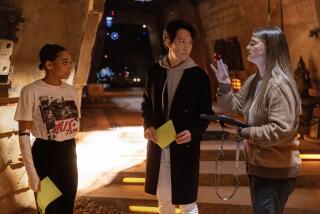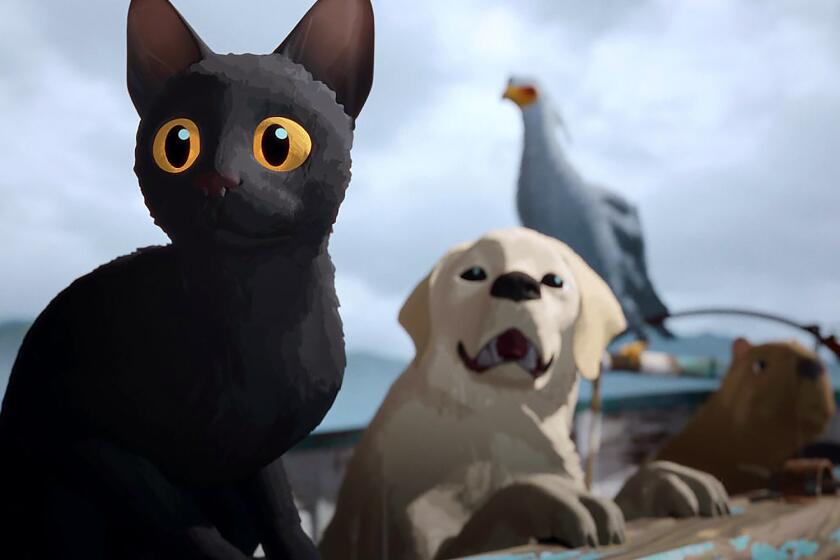From the Archives: It looks hot ...
Never but never underestimate the power of the dark side of the Force. It has made “Episode III Revenge of the Sith” into easily the best of the trio of “Star Wars” prequels and has even attempted the tougher assignment of saving writer-director George Lucas from himself.
It’s a tribute to the power and durability of the universe Lucas and company created in the first three “Star Wars” movies that we want to see this episode despite the tedium of the previous two and despite knowing exactly what will happen in it. Or maybe, as with a familiar story told around a campfire, it is precisely our knowledge of how things will work out that makes us interested in the first place.
As anyone who was part of the estimated $3.4-billion worldwide theatrical gross of the previous five “Star Wars” films can tell you, “Revenge of the Sith” is where the beloved Republic turns into the dreaded Empire, and Anakin Skywalker, once thought to be the Chosen One, goes over to the dark side and ends up Darth Vader, he of the heavy breathing and black-on-black ensemble.
Because it contains the creation myth of one of the most durably popular films of our time, and because seeing a potential hero torn between good and evil before succumbing to iniquity is always involving, “Revenge of the Sith” is the most energetic of the prequels, the only one at all worth watching. But that doesn’t mean it is without the weaknesses that scuttled its pair of predecessors. Quite the contrary.
“Revenge of the Sith” begins with one of its areas of strength, combat on screen. An elaborate, multipart action sequence -- which starts with a cataclysmic air battle featuring fast jets swooping between huge air ships and ends focused on individual lightsaber duels -- lasts for close to half an hour and shows that the droids at Industrial Light & Magic have made excellent use of the film’s more than 2,200 visual-effects shots.
The fight has Jedi knights Obi-Wan Kenobi (Ewan McGregor) and Anakin (Hayden Christensen) trying to rescue Supreme Chancellor Palpatine (Ian McDiarmid) from the clutches of the evil brotherhood of the Sith. Their opponents include Count Dooku (Christopher Lee) and the computer-generated rebel leader General Grievous, a rasping villain who resembles nothing so much as a syphilitic grasshopper.
It’s not just in warfare that “Revenge’s” visuals excel. The film is frankly overwhelming in its ability to create a spectacular variety of alternate worlds. Starting with footage from a range of countries, Lucas and his cohorts create everything from the Wookiee homeland of Kashyyyk (Thailand was the backdrop) to the burning world of Mustafar, which began with electrifying footage Lucas had shot during the eruption of Sicily’s Mt. Etna.
Given how strong “Revenge’s” purely visual element is, we leave it with reluctance when the film turns to dialogue to explain a plot that involves not only the Republic’s war with the Sith but a power struggle between the Chancellor and the Jedi Council, which includes old pals Yoda (computer-generated, and voiced by Frank Oz) and Mace Windu (Samuel L. Jackson).
That reluctance does nothing but intensify because, as veterans of the last two films can attest, whatever gift Lucas had for dialogue has deserted him. The language in “Revenge” is banal and stilted, with sentiments of the “Let’s get a move on, we have a battle to win here” variety predominating. Given that one of Lucas’ original inspirations was Saturday afternoon serials (hence his insistence on numbering all six parts), it makes one wonder if the language is intentionally bad, the better to echo the spirit of those long-gone matinees of the golden past.
Lucas’ weakness with words is matched by a marked lack of facility for working with actors, especially where emotional scenes are concerned. That limitation tends to flatten out everyone’s performance (has Jackson ever been this bland, McGregor this uncharismatic?), but it completely cripples the work of poor Natalie Portman as Anakin’s pregnant but still hairdo-challenged wife, Padme.
When the film’s ILM animation director Rob Coleman told Premiere magazine that “George enjoys the postproduction process the most, I get so much more of his time than the actors do,” he was unknowingly putting his finger on the flaw that keeps these films dramatically leaden and earthbound, however much their visuals soar to the heavens and beyond.
Finally, however, George Lucas does not seem to care. He owns the “Star Wars” concept outright and clearly feels that this is his world to do with as he pleases. If he wants to put in a big close-up of Jar Jar Binks to metaphorically thumb his nose at the creature’s detractors, he does so. If he wants to put in lines that sound as if they reflect as much on the current political situation as the one in the future -- as when Padme listens to the Senate cheer and says, “This is how liberty dies, with thunderous applause” -- he does. Lucas must feel he’s earned the right to be this way, and from one point of view he has.
Although the “Star Wars” universe wouldn’t exist if Lucas hadn’t fought for it and taken it more seriously than anyone else, he seems to be taking it so seriously today that the raffish energy and wised-up sense of humor that marked the very first “Star Wars” is completely gone from the scene.
Though the return of Darth Vader provides “Revenge of the Sith” with a classic film moment that lives up to expectations, the people we’d really like to see make a comeback are Mark Hamill, Carrie Fisher and, most of all, Harrison Ford.
It is not to be, of course, but that only makes us miss them even more.
Back to the collection of reviews.
More to Read
Only good movies
Get the Indie Focus newsletter, Mark Olsen's weekly guide to the world of cinema.
You may occasionally receive promotional content from the Los Angeles Times.











